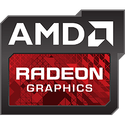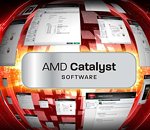Wednesday, May 20th 2015

It's Now Been Over 160 Days Since a Catalyst WHQL Release
As of today (20/05/2015), it has been over 160 days since AMD released a WHQL-signed Catalyst driver update, in what is a clear sign of decay in the company's after-sales support for the consumer graphics market. Once tuned to a near-monthly release of its Catalyst Software suite, which added optimzations for new games, improved upon support for existing ones; CrossFire multi-GPU support profiles; even if not adding support for new GPUs; AMD slipped into quarterly WHQL release cycle in 2013-14. It now seems to have deviated from even that.
The company's last WHQL-signed Catalyst release was Catalyst 14.12 Omega WHQL, which released on 09/12/2014, 161 days ago. The company has since only released two "Beta" drivers, notably Catalyst 15.4 Beta, with optimization for Grand Theft Auto V, and AMD FreeSync support. In contrast, NVIDIA adopted a faster driver update cycle than its previous monthly GeForce WHQL driver releases, under its "Game Ready" driver program. New WHQL-signed releases predate almost every AAA PC game release. There's still no word on a Catalyst WHQL update, and with launch of new graphics cards slated for the third week of June, it's unlikely that the company will release one interim. By then, it will have been 196 days since a Catalyst WHQL driver release. Such a slow driver update cycle would do little to inspire confidence in buying the next-generation Radeon product, even if it establishes a performance lead over GeForce.
The company's last WHQL-signed Catalyst release was Catalyst 14.12 Omega WHQL, which released on 09/12/2014, 161 days ago. The company has since only released two "Beta" drivers, notably Catalyst 15.4 Beta, with optimization for Grand Theft Auto V, and AMD FreeSync support. In contrast, NVIDIA adopted a faster driver update cycle than its previous monthly GeForce WHQL driver releases, under its "Game Ready" driver program. New WHQL-signed releases predate almost every AAA PC game release. There's still no word on a Catalyst WHQL update, and with launch of new graphics cards slated for the third week of June, it's unlikely that the company will release one interim. By then, it will have been 196 days since a Catalyst WHQL driver release. Such a slow driver update cycle would do little to inspire confidence in buying the next-generation Radeon product, even if it establishes a performance lead over GeForce.

161 Comments on It's Now Been Over 160 Days Since a Catalyst WHQL Release
Alternatively you could also write about Gameworks licensees dragging their feet with CF support and performance optimizations on AMD cards. Farcry took 4 months and a game patch and Techland took six weeks and a game patch to support CF. If you are looking out for gamers interest write about how Gameworks and by extension its licensees are harming both AMD and Nvidia consumers (suckers who bought their last gen). Do that and write an editorial if you have lot of time.
Well you can't blame NVidia for designing better drivers, and designing their video cards. to do better more efficient work of detail.
For so long I have had AMD in my computers. I recommended them for all my friends. since the athlon XP days. The last few vid cards including current are AMD except for a 8800GTS.
But lately Im completely bemused how they are even functioning as a company. I dont know how they are getting away with such poor decisions. That isnt the fanboy talking. for at least 5 years they havent had a CPU. and their GFX share has been dwindling away since then as well. I think ive seen as low as 16% share in DISCREET
from NV's point of view they have released the 900 series that is the best chip. its using the least amount of power. They are releasing drivers with games. which means they are working with developers closely.
AMd can do all of this too. and give me a great experience. But they arent! It's like they want to fail! I really believe that!
And now this fiji 4gb. HBM is limited to 4gb which means its not going to do 4K well at all. even if they do a 295X2 again. its still only going to be 4gb until DX12. as we all know Xfire doesnt pool memory. so its a fail before they even release it!
AMD have pretty much made my choice for them, as I said I have had AMD in my PC's since FOREVER.
3 months ago I finally got i7. and I kept a R9 280 iin my system. as the 970 doesnt deserve my money. we all know that. so once fiji comes out 980ti will be my next purchase unless 290X respin has good power savings, and 8GB and reasonable price. It may sway me. but now the driver issue is taking that away. AMD could have worked with game devs, and had drivers ready for each game like NV. but they didnt, and that is poor form!
As for the topic at hand its always worried me a bit. The last real AMD GPU I've owned was a 9700Pro and that was when I was... ignorant about the computer world and didn't need a GPU really for gaming but I needed one at the time so I could watch media. Since than and learning bout computers I've always owned nVidia products. I actually enjoy that knowing with all the hyped or massive profile games that I can rely on nVidia to deliver me "optimized" drivers that day of release most of the time. Quotes for optimized as that's not always true, but 9 out of 10 times they usually deliver and continue to improve. I remember the last major issue being Tomb Raider with TressFX giving nvidia card issues but ... that's how long its been since I've paid attention.
So yes, their drip feed of driver updates for their products do worry me. I enjoy how AMD is trying their hardest to be the enthusiasts friendly company but sometimes I just like my shit to work without me having to tweaking NOTHING. So in the coming weeks when I ditch my 980 x2 for two R9-3xxX model has me a bit worried that times the cards will just flat out fail on me because they don't have the support they need.
In 2009, Saboteur was released - and refused to run on AMD graphics hardware. Being a TWIMTBP title, the accusations immediately flew that Nvidia had nerfed the game for AMD users, only for it to later emerge that AMD had dropped the ball- as Richard Huddy admitted the following year:Hopefully that refreshes your memory. There are other instances for both vendors, but this should suffice as an example of what I meant by driver issues not being solely down to a single cause.
Either way, the company is hurting. It's question of whether it acknowledges it or not, and whether or not it has enough life left to do something about it...
25th of May 2014 - Catalyst 14.4 WHQL got released
the next WHQL would be 14.9, released 158 days later
There is a reason we release frequent drivers... Most notably crossfire profiles for new games. It doesn't take much to repackage a new (or even same) driver with some profiles and slap a WHQL sig on it. The fact that AMD seems incapable of doing this speaks to something going on in the company. I guess it's nothing new, but it's sort of hitting me hard right now being that it's been happening now for an almost historic 2 years.
I don't know what to think of it, but pulling the wool over your eyes and pretending this isn't disturbing isn't helping AMD people.
I actually paid less money for two non-reference R9 290's than I would for a single GTX 980. So no, I'm not "bragging about sinking an ungodly amount of money into my computer" I always seek to find the sweet spot in the performance/price ratio. I thought that I would get great performance from a dual-GPU setup, but sadly this was not the case.
The only options for me to proceed are:
1. Keep the 2x R9 290s and pray to God that I'll get CF support for new games quickly - yeah, right :D
2. Buy GTX 970 - The way Nvidia cut down VRAM and played dumb was appalling. Nvidia are dicks.
3. Buy GTX 980
4. Wait for GTX 980 Ti (lots of power and at least 6GB VRAM) and see if it will not be terribly expensive.
5. Wait for R9 390 - no, screw you AMD, you had your chance.
And another thing. I want to play games on the day of their release (if I have the time) not on some stupid steam sale half a year later.
How can a developer not know that a title they have been working on for years doesn't work as they intended on this or that GPU? Everybody in multiple studios, including both the developers and the publishers QA people, often on different continents, are all running the exact same GPU and driver? No one is checking performance and visuals across multiple platforms using AMD/Intel/nVidia video hardware? How can a developer specify that this particular AMD or nVidia GPU is the minimum required, and that this or that GPU is the one recommended, if they are experiencing brand-related performance problems or haven't actually tested one or the another during development?
Crossfire performance has been an issue for AMD on several occasions. And, I've little doubt that they probably don't have the manpower resources to put out these graphic-related fires as quickly as they would like. But, when a developer is presumably coding in compliance to an existing Microsoft DirectX API, and, despite that, visual issues still arise, should it solely be the responsibility of either AMD or nVidia to adjust their otherwise (mostly) satisfactory drivers to compensate? The developer gets a pass?
I understand that creating visuals for DirectX isn't some rote exercise in terms of coding. Using some creative techniques with a new, or newly-modified, game engine might well expose a shortcoming in an existing driver that does require attention. I really do get that. But, I also get the impression that we're perhaps a bit too quick to criticize the slow response to cleaning-up a mess like that, and maybe not nearly as critical of who actually caused it.
Good to see their continued support, problem is if you are really excited to play a game it's actually better to wait for the driver that fixes it before buying.
AMD's driver issues are ONLY for crossfire/multi GPU solutions.
Single GPU performance is absolutely fantastic.
CF has been out for, like, forever and there's still issues with VSYNC (causes major image distortion and rendering issues), performance drops, utilisation issues.
But this isn't always the case, when it works it works damn well!
And now there are rumors that the new 390x card might cost more money than what people are expecting. Poor driver support and expensive hardware? Yeah, that's going to push people to Nvidia.
I know people don't want to pay more for the 390x, but AMD actually needs to charge more as undercharging for their products has been killing their company. Just look at their net worth on the stock market right now.
They are kind of damned if they do, and damned if they don't, to be quite frank.